Parisian Walkways: Passage du Grand-Cerf
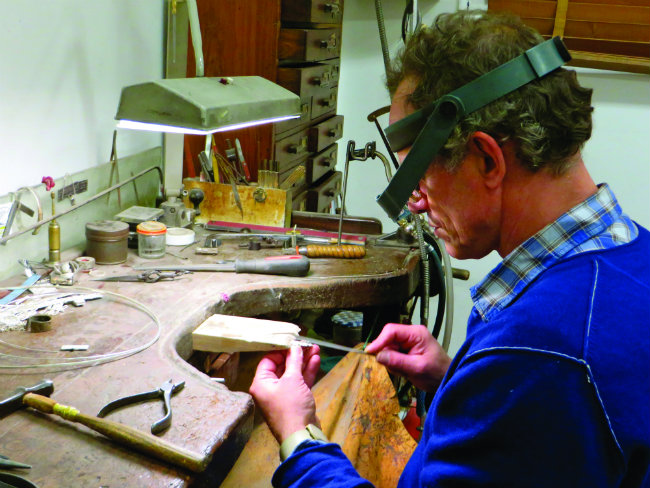
“Come, lovers of Paris, come to Passage Brady all filled with furs, to Passage du Grand-Cerf dressed in its delicate lace of ironwork, to Passage Sainte-Anne, whose guardian is a cat, to Passage du Havre, where one strolls before paintings of horses and piles of collar buttons… Come, and under these crystal canopies, far from the clamour outside, hear in the passing of time the beating heart of the city you love.”
Those words, by the novelist Maurice Bedel in his 1947 Les passages parisiens, still resonate today, such a quintessentially Parisian invention is the covered passageway. A 19th-century adaptation of the Arab souk, le passage parisien was more than just a precursor to the shopping mall, it was a vision of the ideal city: beautiful, industrious, genteel – and mud-free. But of the 20 or so covered passageways remaining in Paris, few have kept the spirit of their early years like Passage du Grand-Cerf, a circa-1825 arcade on the edge of the fashionable Montorgueil neighbourhood.
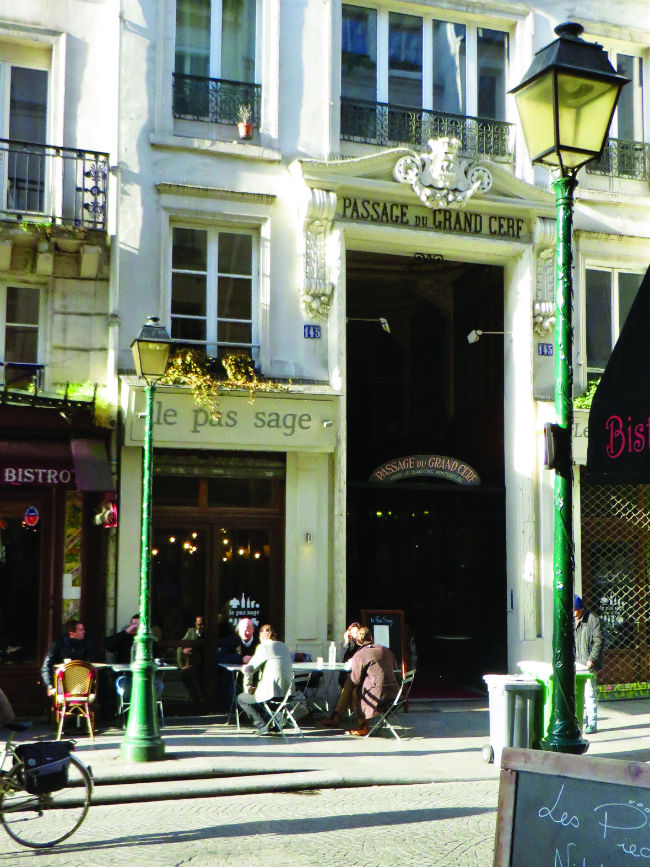
Terrace of Passage Restaurant, passage du Grand Cerf. Photo: Jeffrey T Iverson
Little-known, though just minutes from the Pompidou Centre, Passage du Grand-Cerf, with its smaller, adjoining arcade, Passage du Bourg l’Abbé, is lined with workshop-boutiques of jewellery makers, designers, couturiers and carpenters. it’s a veritable oasis of craftsmanship à la française.
“It’s true we all kind of have the French touch here,” laughs Adrien Plotegher of the vintage glasses shop Pour vos Beaux Yeux (10 passage du Grand Cerf). “We are each in our small way representing forms of micro-innovation, that deserve to be discovered.” Indeed, in Passage du Grand-Cerf, a Paris one might have thought disappeared long ago lives on.

Photo: Jeffrey T Iverson
In 1825, the “Roulage du Grand Cerf” company building on rue Saint Denis, former terminus for the stage coaches of the Messageries Royales, or royal mail service, was demolished to make way for a new kind of covered arcade. The Napoleonic wars had bankrupted France, but with the Restoration of the monarchy in 1814 came an era of resurgent prosperity and creativity. Between 1815 and 1825, the number of patents sky-rocketed. The Passage du Grand-Cerf was designed for this new, industrious Paris, not only to showcase wares, but also for actual production and craft. A towering metal structure allowed for three full levels – space enough for boutiques, workshops and residences.
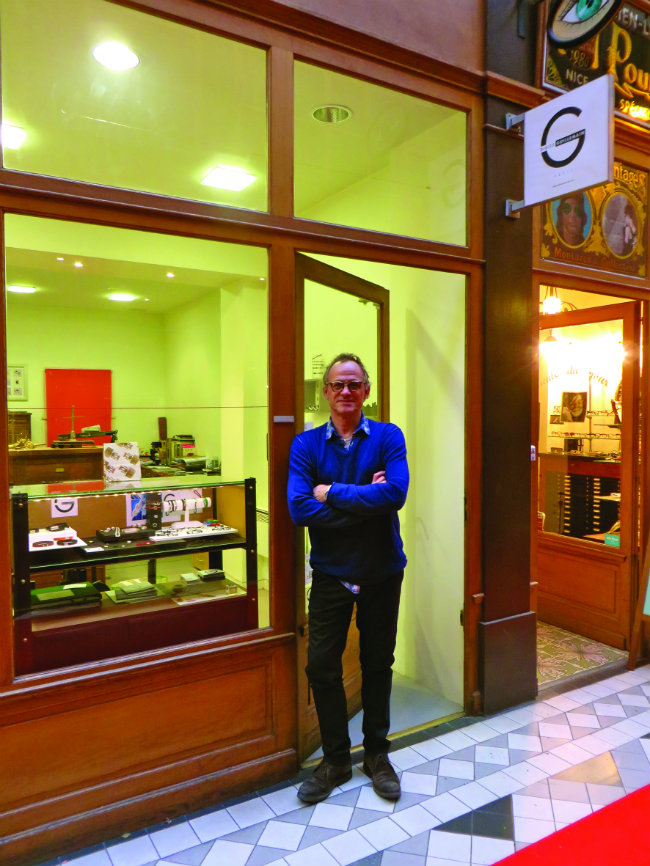
GUILLEMAIN PARIS
photo: Jeffrey T Iverson
Just across Rue Saint Denis from the Passage du Grand-Cerf begins the Passage du Bourg l’Abbé, inaugurated in 1828. The pair of sculptures guarding its entrance confirm that Bourg l’Abbé shared a common vocation with Grand-Cerf: two proud caryatids there represent industry and commerce, and up top, in place of a coat of arms, figures a hive surrounded by honey bees. And for decades, they were buzzing indeed. Unfortunately, as the passages fell out of fashion, they fell into disrepair. By the 20th century, the state of the Grand-Cerf’s glass roof was so perilous the passageway had to be closed. Then, in 1985, a buyer came forward and undertook the major renovation needed to usher the historic arcade into a new era.
When jewellery craftsman Didier Guillemain set up his workshop here in 1998, some of the shops still had bare concrete floors. “It was pretty sauvage,” Guillemain recalls. “It was an odd mix of people. There were button makers, hat makers and fabric merchants that had come over from the Sentier (garment district) nearby.” For Guillemain, who had spent his career working in backroom ateliers for big fashion houses, the Grand-Cerf offered the chance for independence. “Here I could present my own creations directly to public, in the centre of Paris.”
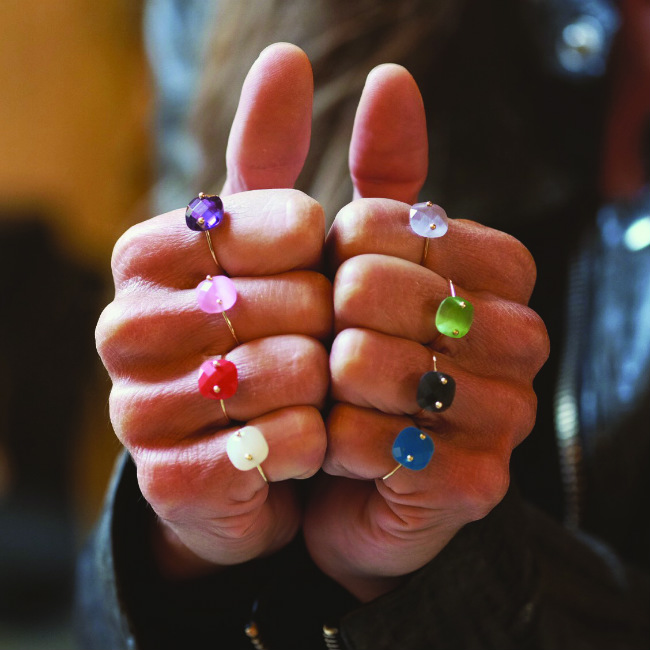
Khara Tuki jewellery.
photo: ©Belloropho
And soon Guillemain had company. “Since the rents were low, the passage drew many young designers who normally couldn’t have afforded their own boutique – even today, it’s still very accessible compared to expensive commercial streets.” Guillemain’s neighbours include Eric Semain and Lydie Chabot, founders of Eric et Lydie (7 passage du Grand-Cerf), a highly successful vintage-style jewellery brand, made famous in part thanks to the patronage of French couture magnate Christian Lacroix. Another designer to get noticed by the fashion world for her jewellery designs is Cécile Boccara (8 passage du Grand-Cerf), who has collaborated with the likes of Valentino. Next door, at Marie et Benoit (6 passage du Grand-Cerf), two designers transform French military surplus into prêt-à-porter and home décor items.
A more recent arrival is Fanny Roux de Badhilac, who opened her atelier-showroom Khara Tuki at 2 passage du Grand-Cerf. Inspired in her jewellery design by distant eras and cultures, de Badhilac felt at home the moment she saw the two neoclassical demoiselles watching over the passageway from the wall carvings above. “I loved this place right away,” she recalls. “It’s this historic ambiance, you feel the spirit of the decorative arts, this universal heritage passed down to us from antiquity.”
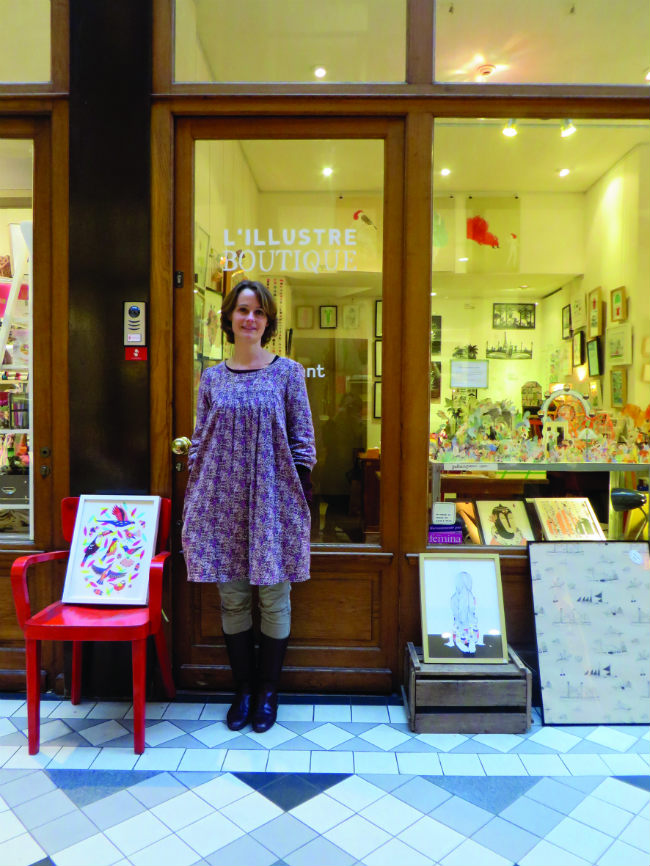
L’ILLUSTRE BOUTIQUE.
photo: Jeffrey T Iverson
With around 17 artisans and designers running shops here today, Guillemain says the Passage du Grand-Cerf is once again the quartier artisanal it was intended to be. “It’s no coincidence that we were all drawn here,” agrees Marguerite Villotte, owner of L’Illustre Boutique (1 passage du Grand-Cerf), a gallery-boutique specializing in illustrative art and paper designs by French artists. “From the organic beauty shop (De Marseille et d’ailleurs, also 1 passage du Grand Cerf) to the jewellery shops creating everything themselves, there is a lot of Made in France here,” says Villotte. “And I think we all share a desire to preserve traditions and savoir-faire that have become rare today.”
Across Rue Saint Denis, Made in France is rapidly becoming the calling card of Passage du Bourg l’Abbé. The start-up Les Petits Frenchies opened a showroom at 15 passage du Bourg l’Abbé in May 2014 for their e-boutique dedicated to new French product trends. Seven months later, Maison Greffeuille opened at the Rue Saint Denis end of the passageway, bringing to Paris the agneau Allaiton, favourite lamb of such chefs as Michel Bras.
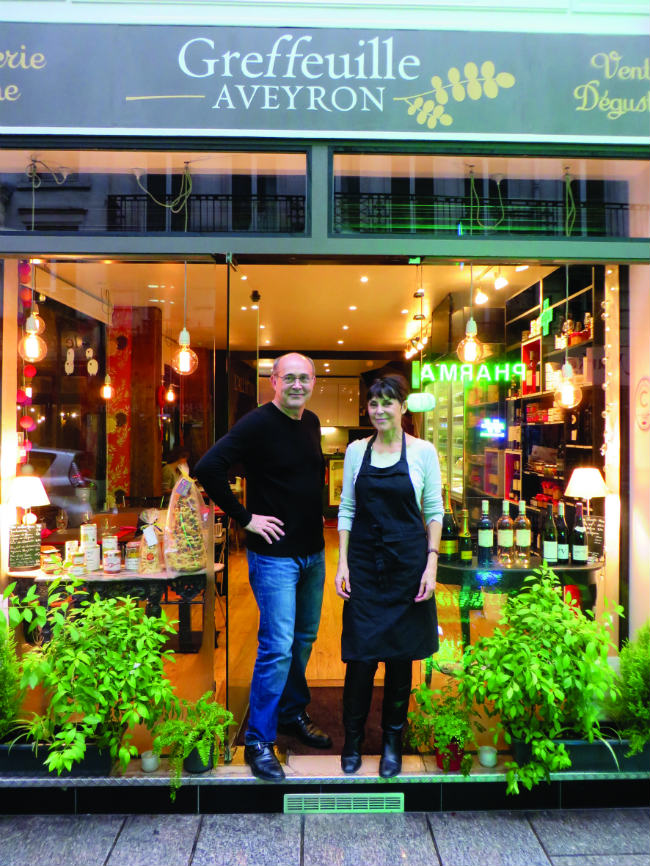
MAISON GREFFEUILLE
photo: Jeffrey T Iverson
Also in December, at 17 passage du Bourg l’Abbé, designer Marilyn Feltz and her artist husband Alexis Gaffuri opened a boutique for her eponymous prêt-à-porter brand. “We created this project as a reflection of our tastes and passions,” says Feltz. “We wanted to celebrate ‘la couture Made in France’, and to showcase French savoir-faire.” Feltz’s breathtaking “Marlene” satin dress is made with 100 per cent Lyon silk. Her cardigans are knitted in the Pyrénées with mohair wool from a young French Angora-goat breeder. The delicate fabric of the “Belleville” ‘50s style dress comes from a Loire Valley weaver that has supplied haute couture houses for three generations.
Probably the most cheerful standardbearer for Made in France in either passageway is Feltz’s neighbour Ivan Lulli. Atelier Lulli (18 passage du Bourg l’Abbé) was founded in 1965 by Ivan’s Italian immigrant father, a gifted artisan who worked metal and wood. Growing up in his father’s workshop, Ivan proved to have an exquisite talent for cabinet-making. Over the last 38 years he has developed a dedicated clientele including actors and fashion designers. “His work is simply magnificent,” says Guillemain of Lulli. “With his know-how, his mastery, his artistry, his principled, rather cantankerous ways, for me he represents the French artisan.”

ATELIER LULLI
photo: Jeffrey T Iverson
Not that Lulli has much competition. “Unfortunately, I’m the last woodworker in the centre of Paris, so people are often shocked when they stumble upon this place,” says Lulli. “The workshop is a magical place, we all had a father or grandfather who was a craftsman, and there’s always an ambience or aroma that stirs nostalgia in people visiting.”
Lulli’s atelier looks more like a museum than a functioning carpentry workshop, so impeccably preserved are the furnishings and tools. But even the Napoleon III-era wood lathe isn’t just there for show. One of Lulli’s creations leaning against the back wall catches the eye: a breathtaking tree of life Lulli sculpted to fit between the oak planks of a parquet floor, with leaves in mahogany, branches in wengé, and a trunk in zebrano. Lulli created an even larger version, several metres in length, for the floor of a wealthy client on Rue Saint Honoré.
For Lulli, it’s not just nostalgia that draws people to his workshop. “People feel a need to return to what’s important today, they want authenticity in their lives. Balzac once said, ‘The café counter is the people’s parliament.’ And workshops, like cafés, are places that bring people together.”
What future for these passages, these bastions of industry and artistry, these colourful corridors of life? It’s nice to imagine that the Passage du Bourg l’Abbé’s lovely old barometer, a jewel of French craftsmanship built by one M. Dutrou in 1862, gives us a clue – for lately, regardless of the actual weather, the arrow has remained stubbornly fixed in a single direction: ‘beau.’
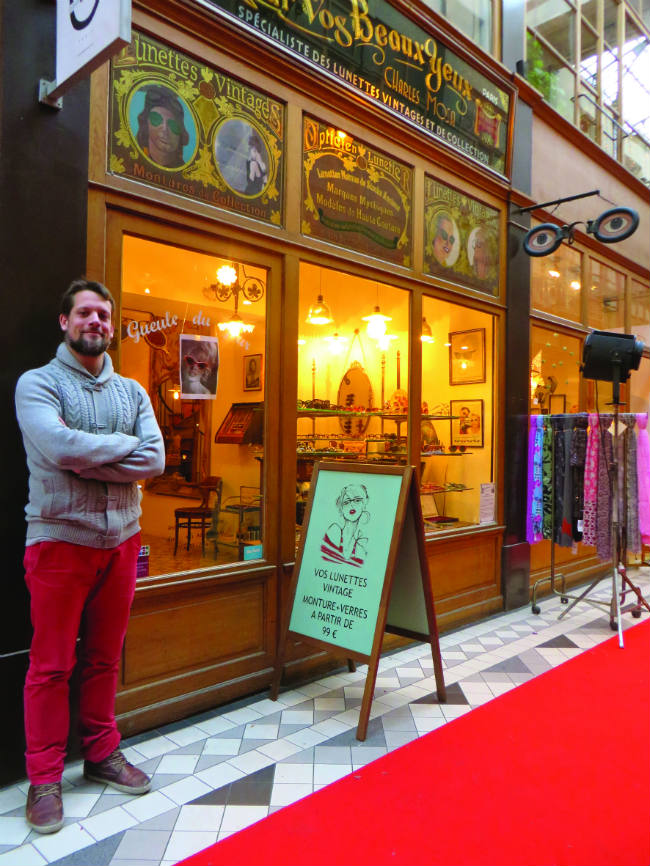
POUR VOS BEAUX YEUX. Photo: Jeffrey T Iverson
ARTISANAL BOUTIQUES
L’ILLUSTRE BOUTIQUE, 1 passage du Grand Cerf, Tel: +33 1 77 16 35 82
Paris has plenty of haughty art galleries and interior decorating franchises, but Marguerite Villotte’s boutique/gallery dedicated to contemporary French illustrative art constitutes a new, welcome niche. Her short-run prints, charming stationery and cards by French artists will thrill art-lovers longing for something original.
POUR VOS BEAUX YEUX, 10 passage du Grand Cerf, Tel: +33 1 42 36 06 79
A glasses shop like no other, PVBY resurrects forgotten overstock to offer authentic, never-worn, vintage frames dating back to 1880. Fashionistas will melt for original Ray Bans and Dior’s first creations; historians and cinephiles will swoon for the spectacles of Gandhi, Teddy Roosevelt or Marilyn Monroe.
GUILLEMAIN PARIS, 10 passage du Grand Cerf, Tel: +33 01 42 33 91 54
Holed away for years in the jewellery workshops of famous fashion houses, Didier Guillemain finally struck out on his own in 1998. Elegant, original, and decidedly avant-garde, Didier’s collections now sell at Galeries Lafayette and BHV, but he still warmly welcomes clients at his Grand-Cerf workshop.
MAISON GREFFEUILLE, 120 rue Saint-Denis, Tel: +33 1 42 36 73 61
The first gourmet boutique from the Aveyron family that made l’agneau Allaiton the favourite lamb of three-star chefs. Laurence Greffeuille offers such delights as artisan Roquefort cheese, genuine aligot potato purée, gâteau à la broche, and their stupendous lamb, to enjoy at home or as deliciously prepared sur place over lunch.
ATELIER LULLI, 18 passage du Bourg l’Abbé, Tel: +33 1 45 08 55 56
The last cabinet-maker in the heart of Paris, Ivan Lulli brings pride and artistry to a disappearing profession in a workshop founded by his father half a century ago. Lulli’s custom designs, made from the nest woods, have won him a clientele of discerning taste, from designer Pierre Cardin to actress Catherine Deneuve.
MARILYN FELTZ, 17 passage du Bourg l’Abbé, Tel: +33 1 40 26 39 48
Isn’t high-quality, handmade, affordable designer clothing a thing of the past? Marilyn Feltz proves otherwise, with her 100 per cent Made in France prêt-à-porter. Inspired by classic cinema silhouettes and assembled in central Paris using Calais lace, Lyons silk, and Pyrénées mohair, Marilyn’s collections celebrate French savoir-faire.
From France Today magazine

MARILYN FELTZ
photo: Jeffrey T Iverson
Share to: Facebook Twitter LinkedIn Email
Leave a reply
Your email address will not be published. Required fields are marked *




REPLY
REPLY
REPLY
REPLY
REPLY
REPLY
REPLY